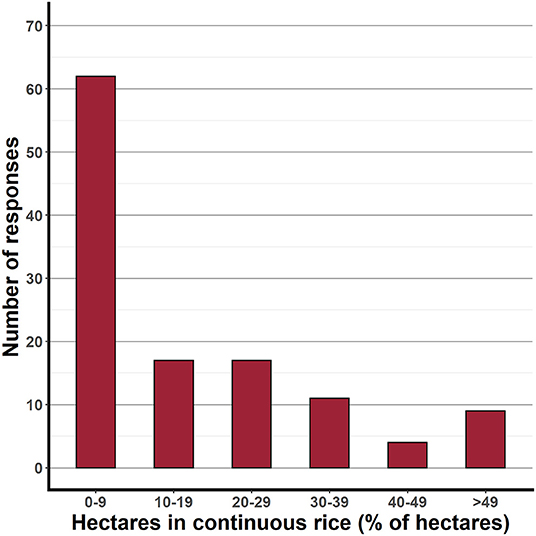- 1Department of Crop, Soil, and Environmental Sciences, University of Arkansas System Division of Agriculture, Lonoke, AR, United States
- 2Department of Crop, Soil, and Environmental Sciences, University of Arkansas System Division of Agriculture, Fayetteville, AR, United States
An online survey to better understand current weed management practices and concerns in Arkansas rice was distributed in the fall of 2020. A total of 123 respondents from across the Arkansas rice growing region returned the survey covering a total of 236,414 rice hectares, representing about 40% of the planted Arkansas rice hectares in 2020. The most problematic weeds were Echinochloa crus-galli (L.) P. Beauv. (ECG), Cyperus spp., and Oryza sativa L. (weedy rice), respectively, in flooded rice, and ECG, Amaranthus palmeri S. Wats., and Cyperus spp., respectively, in furrow-irrigated rice. Most respondents (78%) reported high concern with herbicide-resistant weeds, and crop rotation (>74%) was the most common strategy listed to control and mitigate the development of herbicide-resistant weeds. A chi-square test of homogeneity showed that strategies implemented to control herbicide-resistant weeds and mitigate the evolution of herbicide-resistant weeds were not dependent on occupation type (farmer, consultant, or industry rep) nor on years of involvement in rice production. Respondents failed to control ECG 44% of the time with their first postemergence herbicide. After initial herbicide failure, 53% of respondents stated two additional herbicide applications were required to control ECG escapes while another 21% of respondents stated it was never controlled. The average ECG population at 2020 harvest was between 0.1 and 1.0 plant m−2 according to 44% of the respondents; however, 41% of respondents indicated an ECG density of 2 to 10 plants m−2 at 2020 harvest. The reported annual average cost of herbicides for rice weed control was $266.40 ha−1 with ECG accounting for 81% of the total cost. Average yield loss attributed to ECG was estimated to be 505–959 kg ha−1 (economic loss of $134–254 ha−1). However, yield loss in the most heavily infested fields was estimated to be 757–1,464 kg ha−1 (economic loss of $200–387 ha−1). Effective, non-chemical approaches to weed management were ranked as the least important current research or educational effort, indicating a paradigm shift in rice producers' weed control line of thought is needed with dwindling herbicide options due to herbicide resistance.
Introduction
Rice (Oryza sativa L.) has a production of ~480 million metric tons of milled rice annually and feeds more than half of the world population (Muthayya et al., 2014). The United States (US) produced 10.3 million metric tons of rough rice in 2020, and this production is accomplished mainly in the four regions of the Arkansas Grand Prairie, Mississippi Delta (parts of Arkansas, Mississippi, Missouri, and Louisiana), Gulf Coast (Texas and Southwest Louisiana), and Sacramento Valley of California (USDA-ERS, 2022). With more than 56% of the US long-grain crop (USDA-ERS, 2022), Arkansas is the leading rice producer in the country (Rouse et al., 2018). Rice production accounts for more than US$1 billion yearly in Arkansas and is a main contributing factor to its economy (USDA-NASS, 2022). However, weed competition is particularly detrimental to rice production with yield reductions > 50% (Ziska et al., 2015). Echinochloa crus-galli (L.) P. Beauv. (ECG) can provoke more than 55% grain yield reduction (Zhang et al., 2017) while competition from Oryza sativa L. (weedy rice) can induce up to 72% reduction in the number of filled grains (Martin and Tanzo, 2015). Additionally, rice weed species can decrease land value (Ottis and Talbert, 2007), increase the soil seedbank (Bagavathiannan et al., 2011), and lead to price dockages because of contaminated rice seed. Rice growers in Arkansas rely heavily on herbicides for weed management (Rouse et al., 2018; Barber et al., 2022). However, chemical weed control and alternative integrated weed management strategies in rice production systems have significantly evolved throughout the years as well as rice herbicide traits and weed spectrum.
Since the 1950s, herbicides have been used in US rice production systems to selectively manage major weeds such as Echinochloa spp, Oryza sativa L., Diplachne spp., Sesbania herbacea (P. Mill) McVaugh, and Aeschynomene virginica (L.) B.S.P. Propanil was introduced in Arkansas in 1959 as the first highly effective and primary herbicide for weed control in rice (Rouse et al., 2018). It was continually used for 3 decades until the development of propanil-resistant ECG in 1990 (Heap, 2022). Today, ECG resistance to multiple herbicide sites-of-action has been documented (Barber et al., 2022; Heap, 2022), leading to numerous control failures across the state when chemical control strategies are solely used.
Improving weed control in complex and dynamic weed communities requires integrated approaches to weed management (Norsworthy et al., 2012). The aforementioned escalation of herbicide resistance in important rice weeds (Heap, 2022) increased the interest in more diverse weed management tactics (Owen et al., 2015). Integrated weed management (IWM), a combination of multiple weed control methods (cultural, mechanical, biological, and chemical) (Harker and O'Donovan, 2013), is meant to help growers make informed weed-management decisions and diversify strategies based on scientific knowledge (Swanton et al., 2008). As a holistic approach, IWM provides crops a competitive advantage over weeds and reduces selection for herbicide resistance. Strategies commonly used in rice include prevention (weed-free certified seeds, clean equipment, control of volunteer-weeds in ditches, fence lines and field edges) (Norsworthy et al., 2012; Riar et al., 2013a), herbicide-resistant trait technology (Clearfield®, FullPage®, Provisia®, MaxAce®), cultural practices (cultivar selection, rotation, cover crops, planting date, irrigation management), and mechanical practices (tillage). But the level of implementation of IWM strategies and the barriers to adoption of certain IWM strategies must be evaluated for defining future research opportunities (Swanton et al., 2008).
Weed management surveys are important decision-making tools that help to improve our comprehension of the levels of adoption of production practices and the short- and long-term impact of these practices on weed populations (Norsworthy et al., 2013). They are essential for identifying the most problematic weeds and shifts in the weed spectrum and for setting future research and educational priorities (Norsworthy et al., 2007). Weed management surveys have been conducted in Arkansas in the past to evaluate growers' and consultants' perception of problematic weeds and identify weed management challenges (Norsworthy et al., 2007, 2013; Burgos et al., 2021). However, herbicide resistance has increased in Arkansas since 2011 and weed management practices have changed. A holistic evaluation of the current weed management practices, problematic weeds, costs of weed control and suggested areas of scientific research that will help growers and stakeholders to improve their ongoing management strategies is needed. Therefore, the objective of this research was to assess changes in production practices, shifts in general weed management strategies and weed spectrums, herbicide resistance concerns, and current weed management costs in Arkansas rice.
Materials and Methods
A survey was established and distributed to better understand current weed management practices and concerns in Arkansas rice. The online survey was conducted using the Qualtrics survey platform (Qualtrics, Provo, UT 84604 USA) and was distributed through multiple vectors in the fall of 2020. A link to the survey and short description were direct-emailed to 106 members of the Arkansas Agricultural Consultant's Association and 126 Arkansas County Extension Agricultural Agents. Additionally, the survey link was distributed and publicized through multiple online media sources. The survey was available online for one month, and all respondents remained anonymous. Specific survey questions can be found in Supplementary Material S1.
The survey included 30 questions divided into four sections detailing respondents' demographics, general rice weed management strategies and economics, herbicide resistance, and ECG. The first section comprised demographic and background information such as employment description, years involved in rice production, county location, and number of rice hectares under supervision. The second section focused on general rice weed control details such as the prevalence of and reasons for continuous rice hectares, cost of average rice herbicide programs, and the most problematic weed species. The premise of the third section was to gather information regarding respondents' perception, concern, and mitigation strategies of herbicide-resistant weeds. The fourth section involved an in-depth investigation of ECG to evaluate the prevalence and average densities of ECG in Arkansas rice hectares, perceived herbicide resistance, and effective strategies for the successful control of this problematic weed species.
Data collected from the online survey software were directly imported into a spreadsheet software (Microsoft® Excel® for Office 365, version 2002, Redmond, WA 98052) for analysis (Shaw et al., 2009). One question requested survey participants to provide the three most problematic weeds in flooded and furrow-irrigated rice and to rank them based on importance, with 1 being the most important. Weeds listed as the #1, #2, and #3 most problematic were awarded 3, 2, and 1 points, respectively, and points were summed. Greater total points indicated the respective weed species was more consistently listed as a top problematic weed species in Arkansas rice hectares. Several questions permitted respondents to provide more than one answer resulting in a total number of weed species responses greater than the number of individual respondents. In these instances, the number of observations (n) presented refer to the number of specific individual respondents to the respective question.
Another question requested survey participants to provide two areas of weed management research that would benefit their operation's profitability and/or overall weed control. These results were summarized in two separate ways. First, each response was analyzed for singular keywords or short phrases to provide a broad spectrum look at respondent's perceived needs. These keywords were then analyzed for word frequency and a word cloud was generated using the “tm”, “SnowballC”, and “wordcloud” packages in R 3.5.1 statistical software (R Core Team, 2018). Secondly, responses to this open-ended question were grouped into broader categories of research to provide a more generalized view for future research directions.
A chi-square test of homogeneity comparing respondents' primary occupation and years of active involvement in rice production with strategies implemented to control or mitigate herbicide-resistant weeds was performed using proc freq in SAS v9.4 (SAS Institute, Cary, NC 27513). Not all respondents provided an answer to every survey question. The total number of observations (n) are included for each survey question presented in the results and discussion sections.
Results
Demographics
A total of 123 responses were received encompassing 34 out of 39 rice-producing counties, and accounting for 236,414 hectares out of the 583,152 harvested rice hectares (40.5%) in Arkansas for 2020 (Hardke, 2021) (Table 1). Of the 123 respondents, 55, 45, 19, and 4 respondents reported their primary occupation as farmer, consultant, industry representative, and “other”, respectively (Table 1). Respondents that selected “other” each fell into more than one of the designated categories. Most survey participants (75%) had been actively involved in rice production for 11 years or more (n = 122) (data not shown). Fifty percent had been actively involved in rice production for 21 years or more. Only 5% of survey participants had been active in rice production for <6 years.
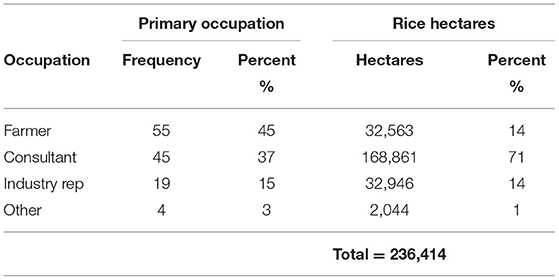
Table 1. Occupation and rice hectares of respondents collected from a rice weed management survey conducted in 2020 in Arkansas, USA (n = 123).
Problematic Rice Weeds and Perceived Weed Research Needs
A total of 105 responses were returned for flooded rice and 92 responses were returned for furrow-irrigated rice regarding the most problematic weed species in the respective production systems. Results revealed that in flooded rice the most problematic weeds were ECG, followed by Cyperus spp., and Oryza sativa L., respectively, while in furrow-irrigated rice they were, in order of importance, ECG, Amaranthus palmeri S. Wats., and Cyperus spp. (Figure 1). ECG recorded the largest total number of points in flooded (292 of a possible 315) and furrow-irrigated rice (236 of a possible 276) indicating nearly every respondent considered ECG to be the #1 most problematic weed species in rice, regardless of growing environment. Cyperus spp. included Cyperus iria L., Cyperus esculentus L., Cyperus difformis L., Cyperus flavicomus Michx., and the generic term “sedges”. Oryza sativa L., the third most problematic weed in flooded rice, was the sixth most problematic weed in furrow-irrigated rice. Diplachne spp. were perceived as the fourth most problematic weeds in flooded rice and fifth most problematic in furrow-irrigated rice. Other problematic weeds reported in flooded rice by respondents were Urochloa platyphylla (Munro ex C. Wright) R.D. Webster, Aeschynomene virginica (L.) B.S.P., Amaranthus palmeri S. Wats., Sesbania herbacea (P. Mill) McVaugh, and Digitaria spp. In furrow-irrigated rice, other reported weeds included Digitaria spp., Sesbania herbacea (P. Mill) McVaugh, Sorghum halepense (L.) Pers., Eleusine indica (L.) Gaertn., and Urochloa platyphylla (Munro ex C. Wright) R.D. Webster. Therefore, the top two problematic broadleaf weeds in flooded rice were Amaranthus palmeri S. Wats. and Aeschynomene virginica (L.) B.S.P., while the top two problematic broadleaf weeds in furrow-irrigated rice were Amaranthus palmeri S. Wats. and Sesbania herbacea (P. Mill) McVaugh.
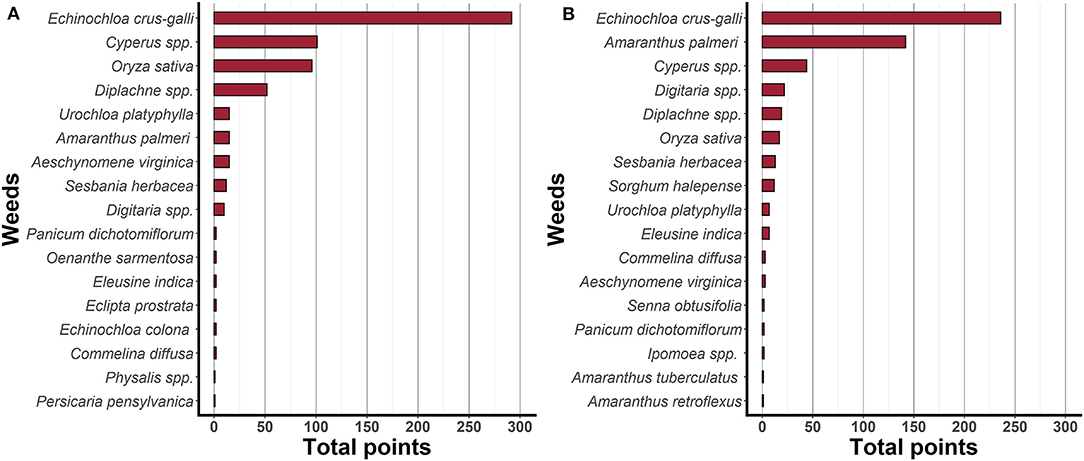
Figure 1. Most problematic weed species reported in (A) paddy rice (N = 105) and (B) furrow-irrigated-rice (N = 92). Weeds listed as the #1, #2, and #3 most problematic were awarded 3, 2, and 1 points, respectively. Greater total points indicate the respective weed species was more consistently listed as a top problematic weed species in Arkansas rice hectares. (A) Cyperus spp. included: Cyperus spp. (56), Cyperus iria L. (38), Cyperus esculentus L. (3), Cyperus flavicomus Michx. (2), and Cyperus difformis L. (2). (B) Cyperus spp. included: Cyperus spp. (34), Cyperus iria L. (6), Cyperus difformis L. (3), and Cyperus esculentus L. (1).
Results from the question that asked respondents to provide two areas of weed management research that would benefit their operation's profitability and/or overall weed control are presented in Figure 2. Singular keywords or phrases detected most frequently in responses indicated research needs including “Echinochloa-crus-galli” and “MOA” (modes-of-action), followed by “residual”, “resistance”, “preemergence”, and “grass” (Figure 2A). The most generalized common area of weed science research requested by survey respondents was “Control of Echinochloa crus-galli” (27 responses) (Figure 2B). “Preemergence or residual herbicide effectiveness” and “development of new modes of action or chemistry” each received 21 responses as an important area of research that would benefit rice production. “Herbicide resistance” (16 responses) was the only other reported research need by survey participants to receive a minimum of 10 responses [excluding the catch-all “other” category that included broad-spectrum topics such as biology, agronomy, identification, etc. (12 responses)].
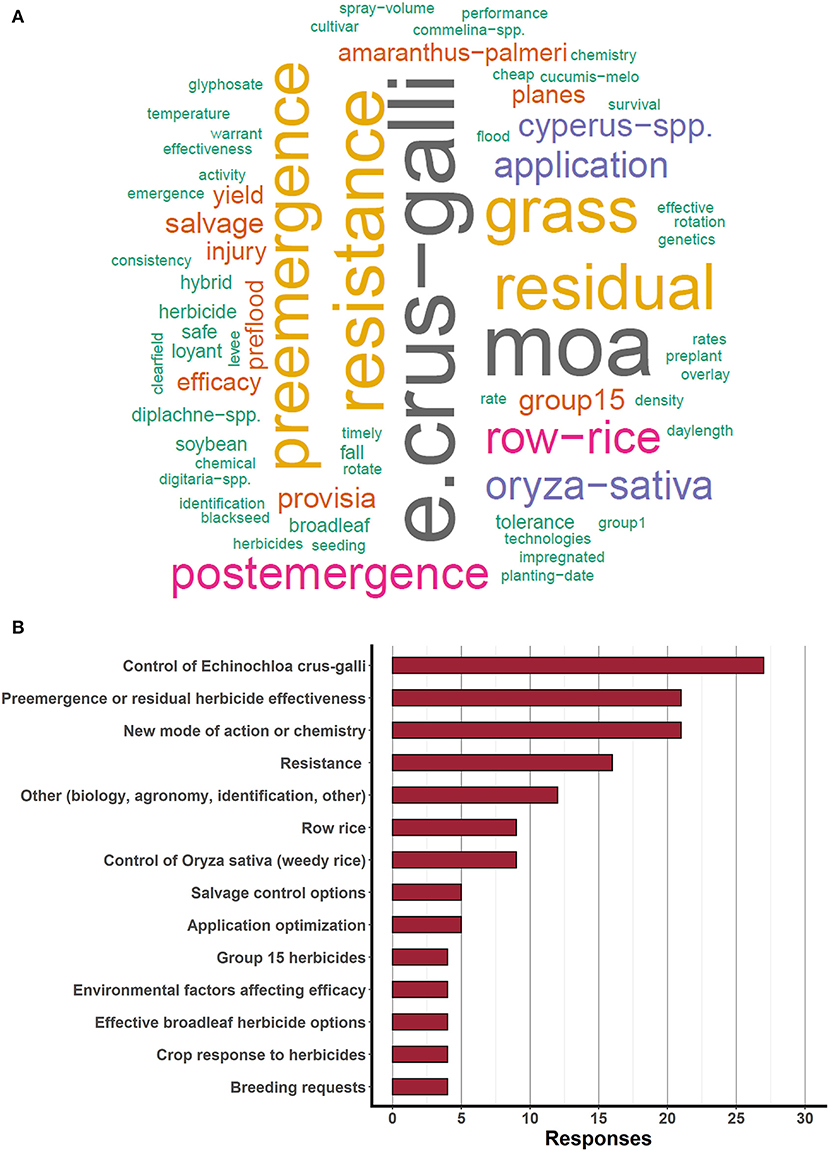
Figure 2. Results for perceived areas of weed management research needs that would benefit rice producers' operation's profitability and/or overall weed control as reported by survey respondents. (A) WordCloud analysis of singular keywords or phrases generated from responses for rice weed management research needs. Words with a similar size and color received a similar number of responses. The larger the word, the more responses that keyword received [i.e., Echinochloa-crus-galli and MOA (mode-of-action) were the top two responses]. Some respondents provided more than one keyword resulting in a total number of observations greater than individual respondents (n = 124). (B) Groupings of perceived areas into broader categories of research to provide a more generalized view for future research directions (n = 76).
Twelve current research or educational efforts were also rated by importance on a scale of 1 to 5, (where 1 = not important, 2 = slightly important, 3 = moderately important, 4 = very important, and 5 = extremely important). Respondents perceived development of new herbicide options as very important with the highest average ranking of 4.79 (Table 2). One important comment made by a survey participant was, “We need novel solutions to resistance issues. Nothing is working!” However, effective, non-chemical approaches to weed management were ranked as the least important current research or educational effort with an average ranking of 2.97 (slightly to moderately important).
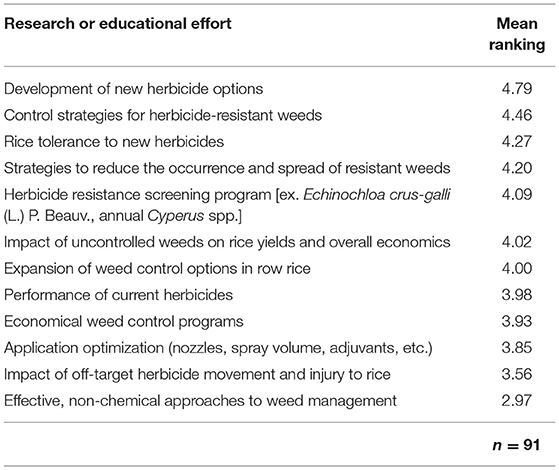
Table 2. Importance of current research or educational efforts as rated by survey respondents on a scale of 1–5, where 1 = not important, 2 = slightly important, 3 = moderately important, 4 = very important, and 5 = extremely important.
Herbicide-Resistant Weeds
Ninety responses were returned regarding the rate of concern for herbicide-resistant weeds (data not shown). Seventy-eight percent of survey participants reported high concern with herbicide-resistant weeds while 21 and 1% of respondents reported moderate and slight concern, respectively. Among farmer respondents, 67% reported high concern with herbicide-resistant weeds while 86% of consultants, 83% of industry representatives, and 100% of other respondents reported high concern with herbicide-resistant weeds (data not shown).
Eighty-four percent of survey respondents also indicated they are managing herbicide-resistant weeds (excluding ECG) currently in their rice hectares (Table 3). When asked to provide the weeds (excluding ECG) and herbicides to which they were resistant, 39% of the respondents (44) reported Cyperus iria L. as resistant to acetolactate synthase (ALS)-inhibitors and synthetic auxin herbicides (Table 4). Oryza sativa L. received the second highest number of responses (19 responses, 17%) and was believed to be resistant to ALS-inhibiting herbicides. Third was Diplachne spp. (13%), thought to be resistant to acetyl-CoA carboxylase (ACCase)-inhibiting, Photosystem II (PSII)-inhibiting, and ALS-inhibiting herbicides. Fourth was Amaranthus palmeri S. Wats. (12%) believed to be resistant to synthetic auxins, PSII-inhibitors, protoporphyrinogen oxidase (PPO)-inhibitors, and 5-enolpyruvylshikimate-3-phosphate synthase (EPSPS)-inhibitor.

Table 3. Respondents' suspicion of the existence of herbicide-resistant weeds [excluding Echinochloa crus-galli (L.) P. Beauv.] in the rice fields they farm or scout and whether they were implementing strategies to minimize the occurrence of herbicide resistance evolution or spread of resistance.
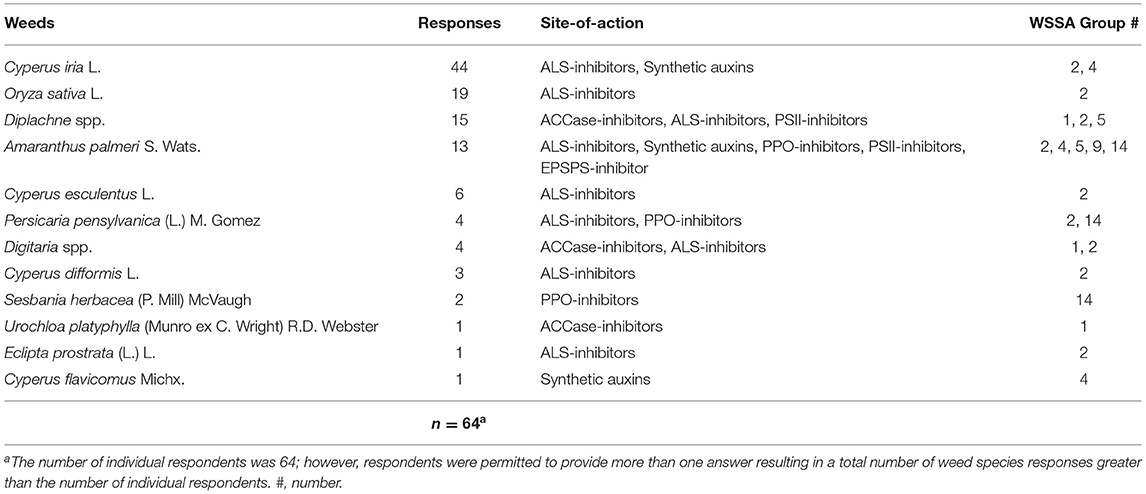
Table 4. Weed species [excluding Echinochloa crus-galli (L.) P. Beauv.] suspected of herbicide resistance as reported by survey respondents and the herbicide site-of-action and WSSA Group # to which they are suspected resistant to.
Eighty-six responses were returned for the question, “Are you implementing any strategies to minimize the occurrence of new herbicide-resistant weeds or spread of resistance?” Thirteen percent of the total number of respondents were not implementing any strategy to minimize the occurrence of new herbicide-resistant weeds or spread of resistance (Table 3).
Seventy-two survey participants that indicated they suspected herbicide-resistant weeds in their rice fields responded to, “What strategies are you using to control herbicide-resistant weeds?” A chi-square test of homogeneity revealed that strategies implemented to control the herbicide-resistant weeds were not dependent on occupation type (chi-square = 2.9, P = 0.82) nor on number of years of involvement in rice production of survey participants (chi-square = 7.3, P = 0.69). Therefore, averaged across all respondents, the most commonly used method reported for managing herbicide-resistant weeds was crop rotation (85%, either alone or in conjunction with other strategies) (Table 5). Eighty-one percent of respondents indicated the use of alternative herbicides either alone or in combination with other methods to manage herbicide-resistant weeds (Table 5). However, 5% of survey participants were using solely alternative herbicides to manage herbicide-resistant weeds (data not shown). Seed (trait) selection (38%), weed seedbank management (31%), and earlier rice planting (24%), were the next most commonly reported methods for managing herbicide-resistant weeds (Table 5).
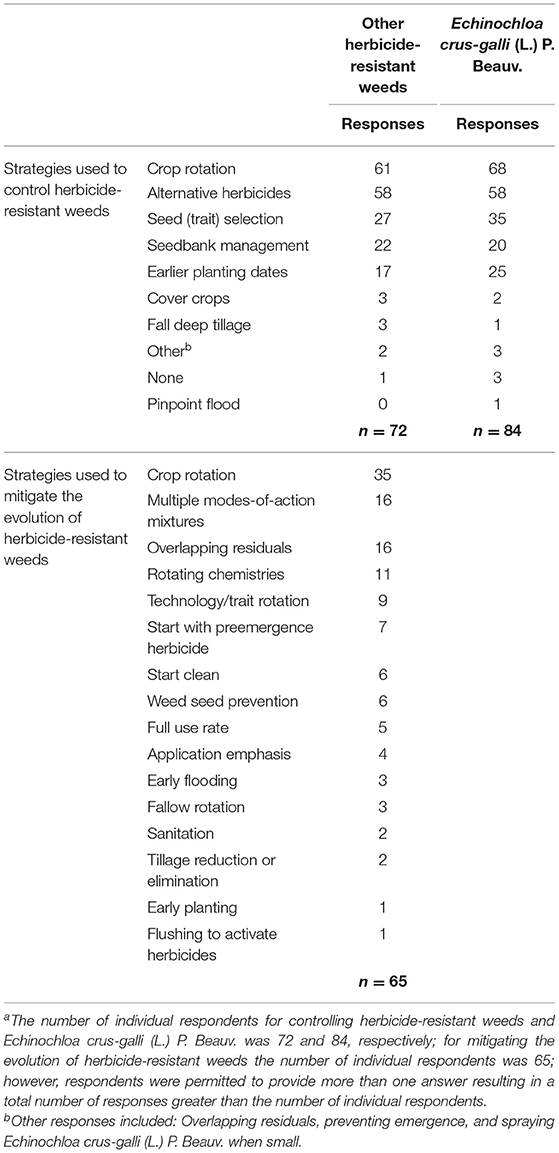
Table 5. Strategies reported from respondents being used to control herbicide-resistant weeds and Echinochloa crus-galli (L.) P. Beauv. and to mitigate the evolution of herbicide-resistant weedsa.
Although crop rotation was listed as a primary method for managing herbicide-resistant weeds, 48% of respondents indicated 10% or more of their reported hectares were in continuous rice (3 consecutive years or more) (Figure 3). When weighted by number of hectares reported, 18% of the total hectares were designated as continuous rice (data not shown). Multiple reasons were provided by respondents as limitations for rice rotation to other crops (Figure 4). Twenty-nine percent of respondents indicated field/soil type was the main limitation for rice rotation to other crops, followed by zero-grade fields (28%) and commodity prices/profitability (23%), respectively.
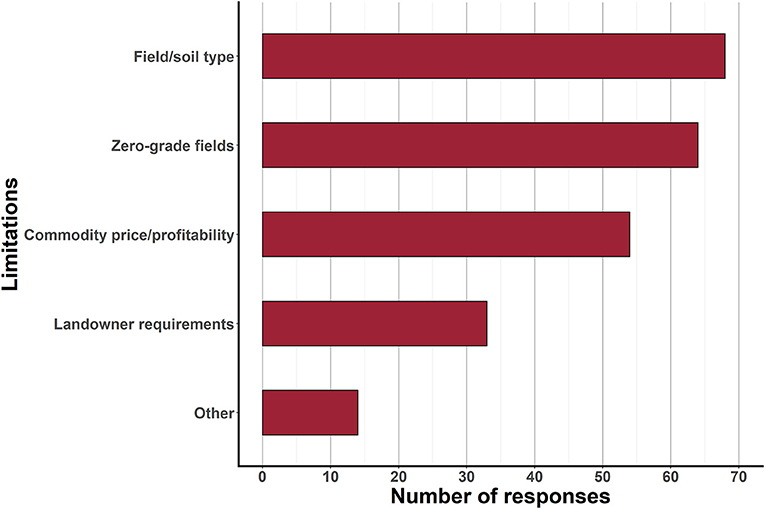
Figure 4. Reported limitations for crop rotation from rice to other cropping systems (n = 118, 233 total responses).
In addition to strategies utilized for managing already established herbicide-resistant weeds, survey participants were asked what strategies, if any, were being implemented to mitigate the evolution of new herbicide-resistant weeds and the spread of current herbicide resistance. Similar to management strategies for current herbicide-resistant weeds, the most commonly implemented mitigation strategy was crop rotation (54%) followed by the use of multiple mode-of-action mixtures and overlapping residuals, each with 25% of respondents indicating use (Table 5). One interesting note, of the 16 strategies that were reported to mitigate herbicide resistance, half involved the use of or improvement of chemical control strategies (Table 5).
Echinochloa crus-galli
Respondents (n = 85) reported that 92% of their rice hectares were infested with ECG equating to 174,323 of a possible 189,522 reported hectares (data not shown). Additionally, 72 survey respondents indicated they believed they had herbicide-resistant ECG on their farm (n = 84, 86%) (Table 6).
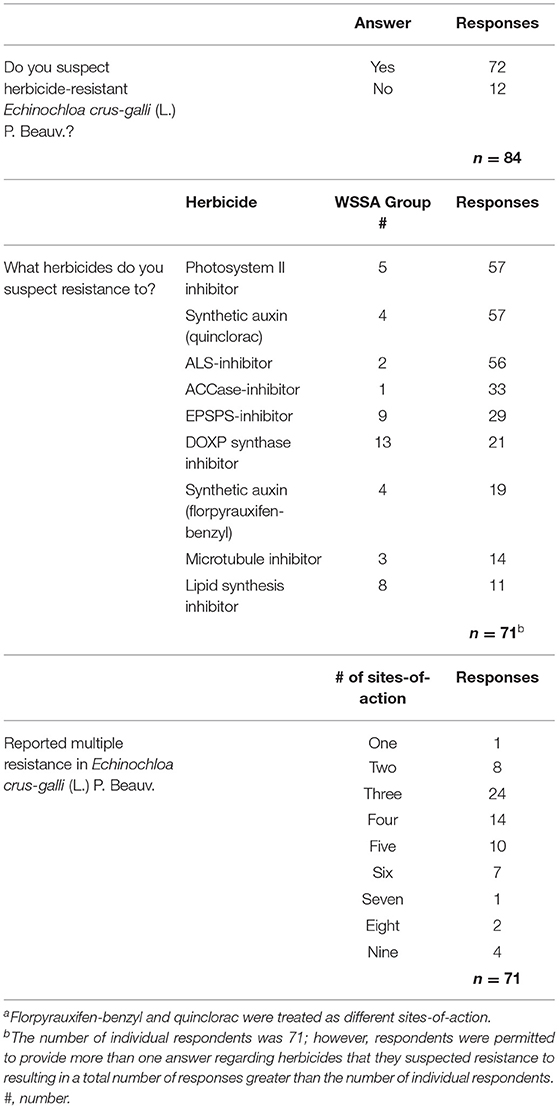
Table 6. Herbicide resistance in Echinochloa crus-galli (L.) P. Beauv. across Arkansas rice hectares as reported by survey respondentsa.
Respondents listed nine different herbicide sites-of-action in which they believed ECG to be resistant to in their rice hectares (Table 6). Most respondents indicated they believed their ECG to be resistant to PSII-inhibitors (WSSA Group 5) (80%), quinclorac synthetic auxin (WSSA Group 4) (80%) and ALS-inhibitors (WSSA Group 2) (79%) (Table 6). Furthermore, 87% of respondents perceived ECG to be multiple-resistant to three sites-of-action or more (Table 6).
Survey participants reported that their first postemergence herbicide application for ECG control often failed. Fifty-two percent of respondents indicated that the first postemergence application failed > 40% of the time with an overall average of 44% of the time (Figure 5). Therefore, almost half of the first postemergence herbicide applications fail to successfully control ECG. After this initial failure from the first postemergence herbicide application, most respondents (53%) believed that two additional postemergence applications were required to effectively control the ECG escapes (Figure 5). Even more concerning, 17 respondents (21%) replied “I never control it” after the initial herbicide failure. When asked to rank the importance of the factors in causing failure of herbicides to control ECG on their farm or scouted hectares on a 1–5 scale (where 1 = not important, 2 = slightly important, 3 = moderately important, 4 = very important, and 5 = extremely important), survey participants perceived herbicide resistance, herbicide selection and weed size at application to be very important (with ranks of 4.28, 4.22, and 4.06, respectively) (Table 7). They also perceived lack of adequate coverage and environmental conditions as moderately to very important with ranks of 3.80 and 3.72, respectively.
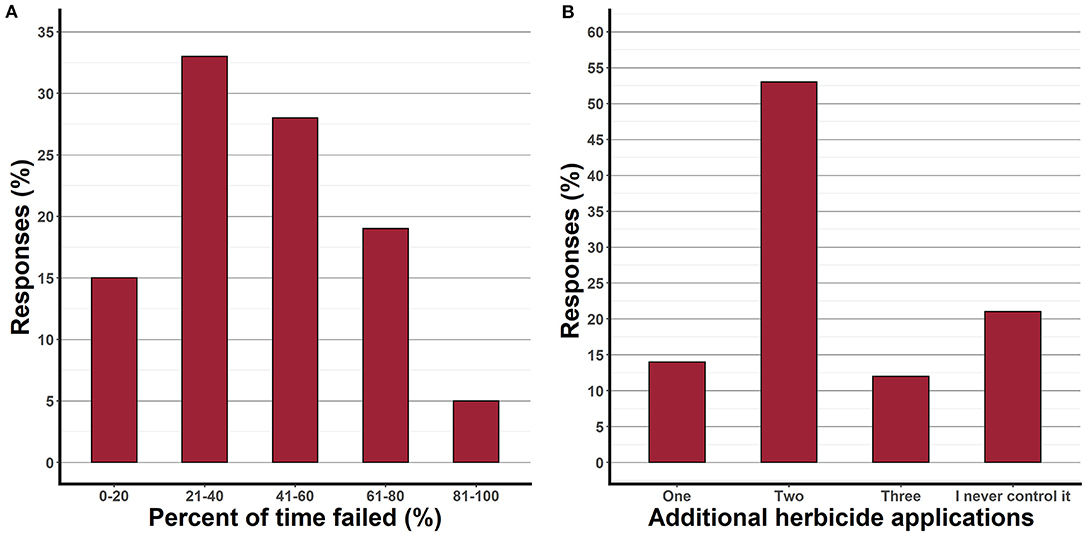
Figure 5. Responses for (A) percent of the time that respondents failed to effectively control Echinochloa crus-galli (L.) P. Beauv. with the first postemergence herbicide application (n = 100) and (B) the average number of additional applications required for Echinochloa crus-galli (L.) P. Beauv. control if the initial application fails (n = 81).
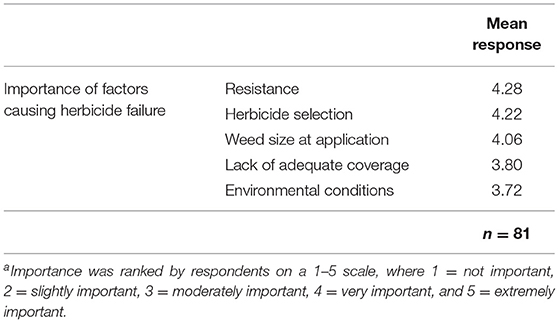
Table 7. Importance of factors causing herbicide failure on Echinochloa crus-galli (L.) P. Beauv. control as reported by survey respondentsa.
ECG densities in the absence of herbicide use (germination potential within a given year based on the soil seedbank) were described to be between 11 and 107 plants m−2 on average by more than half of the respondents (51%) (Table 8). Although the seedbank is plentiful and germination potential is high, 44% of survey respondents thought ECG densities were from 0 to 1 plants m−2 at rice harvest in 2020, while 41% believed they were from 2 to 10 plants m−2 (Table 8).
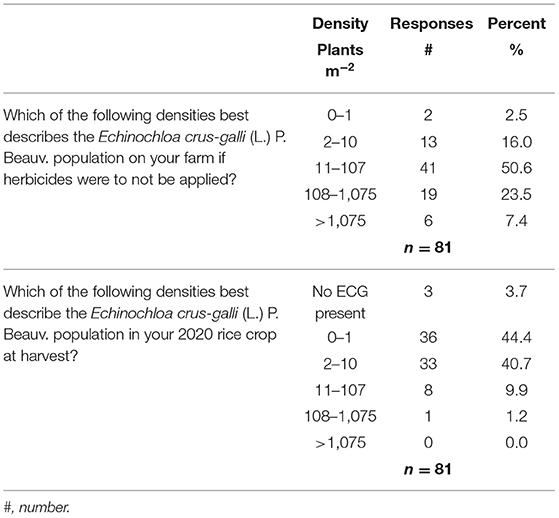
Table 8. Reported Echinochloa crus-galli (L.) P. Beauv. densities if herbicides were to not be applied (germination potential within a given year based on the soil seedbank) and the actual Echinochloa crus-galli (L.) P. Beauv. density present in respondents' 2020 rice crop at harvest.
Survey respondents indicated very similar strategies were employed for ECG control as the aforementioned herbicide-resistant weeds control (Table 5). The chi-square test of homogeneity revealed that strategies implemented to manage ECG were not dependent on occupation type of survey participants (chi-Square = 13.1, P = 0.16) nor on number of years of involvement in rice production (chi-Square = 12.6, P = 0.81). Most survey participants (81%) were using crop rotation alone or in combination with other strategies to manage ECG and alternative herbicides (69%) was the second most commonly used tactic alone or in combination with other strategies to manage ECG (Table 5). Other non-chemical ECG control strategies including seedbank management (24%) and earlier planting dates (30%) were only moderately used.
Cost of Rice Weed Control
The average cost of chemical weed control for reported rice hectares was evaluated during the survey. The perceived average cost of chemical control in rice weighted by hectares reported per respondent was $266.20 ha−1 (n = 113) (Figure 6). When asked, “What percent of your overall herbicide expense this year was for ECG control?”, survey participants estimated ~81% of the total herbicide cost was attributed to ECG which equated to an average cost of $215.90 ha−1 (data not shown).
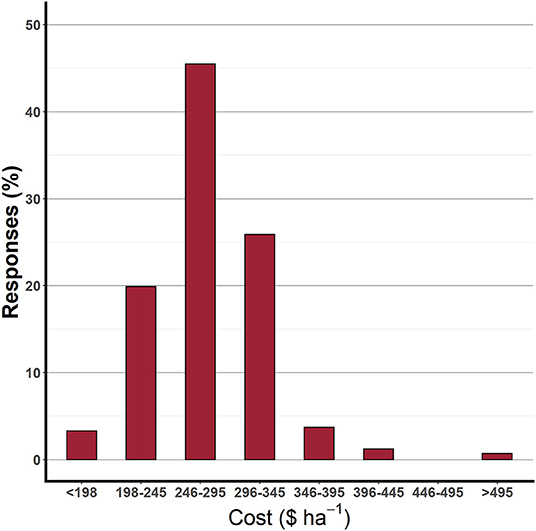
Figure 6. Estimated rice weed control cost ha−1 weighted by hectare reported per respondent (n = 113).
Survey participants were also asked to evaluate the average yield loss on their farms attributed to ECG. Most participants estimated rice yield loss attributed to ECG of 455–959 kg ha−1 (29%) and 203–454 kg ha−1 (29%) (Table 9). Using the average price of $264.50 per metric ton of rough rice in 2020 (USDA-NASS, 2022), the corresponding economic loss would be $121–254 ha−1 and $54–120 ha−1 for 455–959 kg ha−1 and 203–454 kg ha−1, respectively (Table 9). Survey participants were also asked to evaluate the yield loss in their most heavily infested rice field. Most participants (29%) estimated yield loss of 708–1,464 kg ha−1 and 22% of respondents perceived the estimated yield loss to be 1,465–2,221 kg ha−1. The corresponding economic loss would be $188–387 ha−1 and $388–588 ha−1 for 708–1,464 kg ha−1 and 1,465–2,221 kg ha−1, respectively.
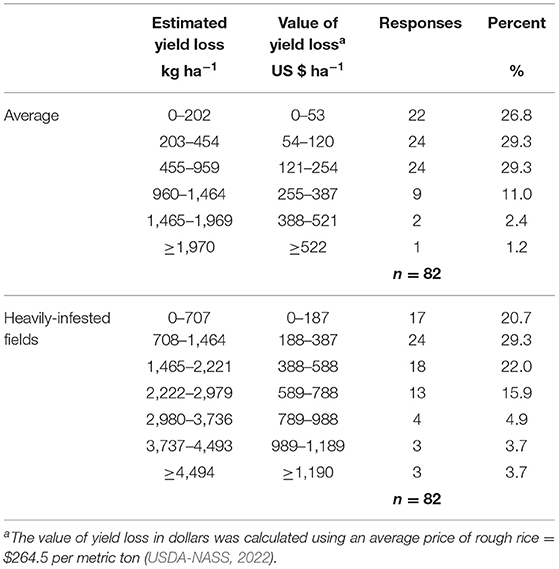
Table 9. Estimated average rice yield loss attributed to Echinochloa crus-galli (L.) P. Beauv. in Arkansas rice fields and estimated yield loss in most heavily infested fields (maximum potential loss) as reported by survey respondents.
Discussion
Problematic Rice Weeds and Perceived Weed Research Needs
The prevalence of ECG as the most detrimental weed in Arkansas rice is consistent with previous survey data that reported it as the most problematic weed in rice production systems (Norsworthy et al., 2007, 2013). ECG was detected in the seedbank of most major cropping systems of Arkansas, and it has a prolonged emergence period from mid-April to late September that contributes to the weeds' success (Bagavathiannan et al., 2011). Cyperus spp. have drastically risen on the Arkansas rice problematic weeds list since the previous survey was conducted in 2011 (Norsworthy et al., 2013). In the previous survey, Cyperus esculentus L. was reported as the 8th most problematic weed, and Cyperus iria L. was not ranked in the top 20; data from the current survey conducted nearly a decade later resulted in the combination of Cyperus spp. being the 2nd most problematic weed species to combat in rice hectares. The presence and spread of ALS-inhibitor-resistant Cyperus esculentus L. and Cyperus iria L. (Norsworthy et al., 2007) might be a major reason why Cyperus spp. are considered so problematic in Arkansas rice.
Oryza sativa L. has held constant as a top four problematic weed species in Arkansas rice as it was previously ranked third in importance and the fourth problematic weed in 2011 (Norsworthy et al., 2013), and more recently, Burgos et al. (2021) also reported it as the third most problematic weed. With infestation levels up to 1,076 plants m−2 (Burgos et al., 2021), multiple reasons might explain its prevalence including resistance to ALS-inhibiting herbicides and the morphological similarity to the rice crop. The prevalence of Amaranthus palmeri S. Wats. in furrow-irrigated rice as the second most troublesome weed is not surprising as it is one of the two most troublesome weeds in Arkansas soybean [Glycine max (L.) Merr.] (Riar et al., 2013b) and furrow-irrigated production removes the cultural practice of flooding as a management tactic. Also, Amaranthus palmeri S. Wats. has evolved resistance to eight different sites-of-action in Arkansas (Barber et al., 2022; Heap, 2022), making it persistent and difficult-to-control across cropping systems. Soybean is the most common rotational crop with rice (Burgos et al., 2021); therefore, the rise of occurrence and herbicide resistance in soybean cropping systems is likely to promote the increase of Amaranthus palmeri S. Wats. infestations in rice fields (Norsworthy et al., 2013).
Although Diplachne spp. dropped from the second most problematic weed species in Arkansas rice in 2011 (Norsworthy et al., 2013) to the fourth and fifth most problematic species in flooded and furrow-irrigated rice, respectively, in the present survey, their occurrence of remaining in the top five most problematic weeds indicates persistence and difficult-to-manage nature. In 2006, Aeschynomene virginica (L.) B.S.P. and Persicaria spp. were the two most problematic broadleaf weeds (Norsworthy et al., 2007), while Aeschynomene virginica (L.) B.S.P. and Amaranthus palmeri S. Wats. were the two most problematic broadleaf weeds in 2011 (Norsworthy et al., 2013). Excluding Amaranthus palmeri S. Wats. in furrow-irrigated rice production, minimal broadleaves were reported in the present survey as truly problematic likely due to the morphological difference from rice and the presence of multiple effective herbicide options (Barber et al., 2022).
The most common area of weed management research reported to benefit the respondent's operation profitability and/or overall weed control was “Control of Echinochloa crus-galli” which was similar to the 2011 survey where ECG control was the most common weed research area recommended by respondents (Norsworthy et al., 2013). Major reasons for this request might include the high infestation levels of ECG when left uncontrolled, reduced commodity price when rice seeds are contaminated with ECG seeds, and the presence of ECG seedbank in most Arkansas cropping systems (cotton, soybean, rice). The request of “pre-emergence herbicides” as a major area of research might be due to failure of postemergence control of weeds in the previous growing seasons, the slower evolution of resistance to some soil applied herbicides, and better understanding the probability for rice injury, causes, and yield loss potential.
The request for research of new modes-of-action or chemistry is likely due to the escalation of herbicide resistance to the existing modes-of-action, the lack of introduction of new herbicides, continued failed attempts at successful weed control, and the continued search for an easy method of weed control. Even though discovery of herbicides with new mechanisms-of-action may help to manage herbicide-resistant weeds, changes in the patterns of herbicide use are required to reduce herbicide resistance evolution (Gaines et al., 2021). Ranking effective, non-chemical approaches to weed management as the least important current research or educational effort, is an indication that a paradigm shift in rice producers' weed control line of thought is needed with dwindling herbicide options due to herbicide resistance.
Herbicide-Resistant Weeds
High herbicide resistance concerns reported in the present research are similar to survey results from nearly a decade ago. Norsworthy et al. (2013) also reported moderate or high concern regarding herbicide resistance from 98% of participants, with resistant weeds suspected in rice fields scouted by 88% of consultants. In Arkansas, resistance has been documented in several major weeds that respondents reported including Oryza sativa L. (ALS-inhibitors), Cyperus iria L. (ALS-inhibitors), Cyperus difformis L. (ALS-inhibitors), Echinochloa colona (L.) Link (ALS-inhibitors, PSII-inhibitors, and synthetic auxins), Cyperus esculentus L. (ALS-inhibitors), and Persicaria pensylvanica (L.) M. Gomez (ALS-inhibitors) (Heap, 2022). However, there have been no confirmed cases of resistance for many of the other herbicides and weeds listed by survey participants which implies that control failure in these cases might be due to factor(s) other than resistance (Norsworthy et al., 2012).
Although respondents provided some alternative weed management strategies to chemical control methods, more efforts (research, educational, and on-farm implementation) are needed to diversify strategies. Breeding of more competitive cultivars, robotic systems for weed control, and use of RNA to silence key weed genes through the process of RNA interference (RNAi) are all potential future options to enhance rice weed management efforts (Westwood et al., 2018). “Breeding efforts” were minimally requested by survey participants as important future weed management research needs (Figure 2). However, breeding new rice cultivars with a competitive advantage over weeds (Shrestha et al., 2020) might help to reduce selection pressure. Additional cultural methods pertaining to breeding or cultivar selection include selection of hybrid rice lines with greater tillering and taller growth characteristics (Shivrain et al., 2009), selection of more competitive rice cultivars and optimizing agronomic conditions (Gealy and Duke, 2017), and full-season cultivars that maximize the period with crop cover (Reddy and Norsworthy, 2010).
Earlier planting dates have been implemented as a strategy to combat herbicide-resistant weeds (Table 5), but could be adopted to a wider extent, especially as a strategy to mitigate the evolution of herbicide resistance development. By planting rice earlier, it provides the crop a competitive advantage by emerging and growing prior to the optimum emergence window for some of our most problematic rice weed species like ECG, Panicum dichotomiflorum Michx., and Amaranthus spp. (Werle et al., 2014). Additionally, winter flooding, seed burial depth, and the stale seedbed technique can help to reduce the size of soil seedbank and weed infestation (Franca et al., 2020). Preventive measures such as weed-free certified seeds and equipment sanitation are also essential (Norsworthy et al., 2012; Riar et al., 2013a). Crop rotation is crucial and has been previously recommended as a key strategy for controlling herbicide-resistant ECG (Norsworthy et al., 2007) and Oryza sativa L. (Norsworthy et al., 2007; Burgos et al., 2021). The most common rotations in Arkansas are rice–soybean, rice–soybean–corn (Zea mays L.), and rice–fallow–soybean (Burgos et al., 2021) with soybean being the most compatible rotational crop with rice because it allows for alternative herbicide programs to be utilized and increases ease of controlling grass species in a broadleaf crop (Burgos et al., 2008).
Although crop rotation has great benefits for weed management and many survey respondents indicated they used this strategy for the management of herbicide-resistant weeds (Table 5), nearly 1/5th of reported rice hectares were under continuous rice production (≥3 years) which is a concerning practice affecting successful long-term weed management. Proportions of different rice varieties grown were not assessed in the present survey, but a previous survey reported imidazolinone-resistant rice was planted on 64% of the planted rice hectares, 42% of which was treated exclusively with an ALS-inhibiting herbicide for grass control (Norsworthy et al., 2013). Therefore, the probability of continuous rice hectares receiving repetitive herbicide treatments annually is high, resulting in the continued selection for herbicide-resistant weeds. Continued education efforts must be implemented to warn against the overuse of specific herbicide technologies and demonstrate the importance of integrated weed management strategies for long-term weed management success.
In Arkansas, several factors such as decreased labor, ease of management, and potentially fewer input costs increased the interest in precision-leveling fields to zero grade (Hardke, 2021). Unfortunately, zero-grading land constrains growers to a continuous rice production system due to limited water movement inhibiting other non-flooded crop production (Hardke, 2018). Although this practice provides some benefits to Arkansas growers, the crop rotation limitation and resulting monoculture agricultural system establishes a weed spectrum that thrives in that specific environment and quickly adapts to the repeated similar management strategies.
Echinochloa crus-galli
ECG was reported as the most problematic weed species in both flooded and furrow-irrigated rice hectares (Figure 1), with 92% of respondents indicating the presence of ECG in their rice fields. With the occurrence of ECG populations with multiple resistance in the midsouthern U.S. (Barber et al., 2022; Heap, 2022), it is logical that a large proportion of the rice weed control budget would be directed toward ECG control. This may also partially explain the high proportion of reported postemergence herbicide failures, in addition to the inconsistency in control observed from herbicides selectively targeting ECG, a very morphologically similar weed species to rice.
In Arkansas, research has documented ECG resistance to six sites-of-action (when considering quinclorac and florpyrauxifen-benzyl as two separate sites-of-action within synthetic auxins): ACCase-inhibitors (WSSA Group 1), ALS-inhibitors (WSSA Group 2), synthetic auxin (quinclorac, WSSA Group 4), synthetic auxin (florpyrauxifen-benzyl, WSSA Group 4), PSII-inhibitor (WSSA Group 5), and DOXP-inhibitor (WSSA Group 13) (Barber et al., 2022; Heap, 2022). Present survey results indicated respondents believed ECG was resistant to a total of nine different sites-of-action (Table 6). Therefore, either there are undocumented instances of herbicide resistance to additional sites-of-action within the state of Arkansas, or these herbicide failures are the result of other factors such as suboptimal environmental conditions, application errors, weed size, or herbicide selection (Table 7). The lack in implementation of alternative, diverse weed management strategies (Table 5) compromise the sustainability of current weed management options.
Postemergence herbicide failures on ECG were common as reported by survey respondents, and twenty-one percent of survey participants said “I never control ECG” following failure of the first postemergence application (Figure 5). In addition to inducing unacceptable yield loss for the simultaneous rice crop, ECG escapes can produce up to 39,000 seeds plant−1 (Bagavathiannan et al., 2012) that will increase the soil seedbank and compromise subsequent growing seasons. In Arkansas rice fields, the ECG seedbank was previously predicted to contain an average of 6,000 seeds m−2 with up to 215,000 seeds m−2 (Bagavathiannan et al., 2011). With 41% of respondents estimating 2–10 ECG plants m−2 at the 2020 harvest, this has the potential to increase the soil seedbank by 78,000–390,000 seeds m−2. A primary recommendation for reducing the risks of herbicide resistance is the use of a diversified approaches to weed management that target the reduction of seed production and the number of weed seeds in the soil seedbank (Norsworthy et al., 2012).
Cost of Rice Weed Control
The high concern for herbicide-resistant weeds reported by respondents in their Arkansas rice hectares is alarming from multiple standpoints. However, one often overlooked facet of herbicide resistance is the significant increase in weed control costs as additional reactive management strategies are required to be implemented (Llewellyn et al., 2002) resulting in an average additional cost of $65.60 ha−1 that can reach up to $98 ha−1 (Norsworthy et al., 2013). Other additional estimated costs associated with herbicide-resistant weeds are crop yield loss, decreased commodity prices due to weed-seed contamination, and reduced land values (Norsworthy et al., 2012).
Season-long interference of ECG with densities between 1 and 20 plants m−2 reduced rice grain yield up to 301 kg ha−1 per ECG plant (Stauber et al., 1991) equating to approximately a $79 ha−1 loss for each additional ECG plant present with 2020 rough rice prices (USDA-NASS, 2022). This ECG density range was reported by >41% of respondents at 2020 Arkansas rice harvest (Table 8). Additionally, heavy infestations of ECG are known to reduce land value by removing 60–80% of nitrogen from the soil (Ottis and Talbert, 2007). In addition to ECG impacts on yield, land value, and the soil seedbank, this weed species is likely to contaminate rice seed at harvest leading to price dockages for the producer.
Although chemical weed control options tend to be simpler and offer increased short-term economic returns, the prevalence of postemergence herbicide failures reported by respondents (Figure 5) would significantly increase this cost. Furthermore, after an initial failure from the first postemergence herbicide application, most respondents (53%) believed that two additional postemergence applications were required to effectively control ECG escapes (Figure 5), resulting in an added expense of ~$150 ha−1 (Barber, personal communication).
Alternative integrated weed management practices are often more laborious to enact and may increase the immediate weed management expense. However, when shifting focus from short-term to long-term economics, and the potential for widespread, multiple site-of-action resistance rendering herbicides non-viable, chemical costs of weed control will drastically increase (Davis and Frisvold, 2017). The implementation of integrated weed management strategies for both the management of current herbicide-resistant weeds and the mitigation of future evolution of herbicide resistance is one of the most effective and economical long-term strategies we currently have today. Respondents in the present survey indicated non-chemical weed management practices as the least important current research effort (Table 2); therefore, educational campaigns to enhance adoption are required with an emphasis placed on illustrating the economic benefits of integrated weed management strategies (Llewellyn et al., 2004).
Conclusions
ECG is the most problematic weed in Arkansas rice. Other major weeds such as Cyperus spp., Oryza sativa L., Diplachne spp., and Amaranthus palmeri S. Wats. are also problematic. Overreliance on chemical weed control cannot provide sustainable control of these weeds as herbicide resistance has been widely documented and is of high concern as indicated by survey respondents. Integrated weed management strategies are required to reduce selection pressure and improve long-term weed management success. However, effective, non-chemical approaches to weed management were ranked as the least important current research or educational effort, indicating a paradigm shift in rice producers' weed control line of thought is needed with dwindling herbicide options due to herbicide resistance. Educational efforts must be established highlighting the long-term weed management and potential economic return benefits by being proactive to implement diversified strategies rather than reactive. Information gathered from the survey provided direct insights into current rice weed management practices and a better understanding of current concerns with making accurate and efficient weed management decisions. Additionally, the information provided will be used to prioritize research and Extension outreach efforts moving forward to address stakeholder needs more effectively.
Data Availability Statement
The raw data supporting the conclusions of this article will be made available by the authors, without undue reservation.
Ethics Statement
The studies involving human participants were reviewed and approved by University of Arkansas Institutional Review Board (IRB). Written informed consent for participation was not required for this study in accordance with the national legislation and the institutional requirements.
Author Contributions
TB contributed to survey development, survey conduction and management, analysis, and writing of manuscript. KK contributed to analysis and writing of manuscript. JN contributed to survey development, analysis, and editing of manuscript. LB contributed to survey development and editing of manuscript. All authors contributed to the article and approved the submitted version.
Funding
Funding for this research was provided by Checkoff funds distributed through the Arkansas Rice Research and Promotion Board.
Conflict of Interest
The authors declare that the research was conducted in the absence of any commercial or financial relationships that could be construed as a potential conflict of interest.
Publisher's Note
All claims expressed in this article are solely those of the authors and do not necessarily represent those of their affiliated organizations, or those of the publisher, the editors and the reviewers. Any product that may be evaluated in this article, or claim that may be made by its manufacturer, is not guaranteed or endorsed by the publisher.
Acknowledgments
The authors wish to thank all the growers, crop consultants, and other rice production agriculturalists who completed the survey. The authors also would like to thank the Arkansas Agricultural Consultant's Association and Arkansas County Extension Agents that helped to distribute the survey.
Supplementary Material
The Supplementary Material for this article can be found online at: https://www.frontiersin.org/articles/10.3389/fagro.2022.881667/full#supplementary-material
References
Bagavathiannan, M. V., Norsworthy, J. K., Smith, K. L., and Burgos, N. (2011). Seedbank size and emergence pattern of barnyardgrass (Echinochloa crus-galli) in Arkansas. Weed Sci. 59, 359–365. doi: 10.1614/WS-D-10-00149.1
Bagavathiannan, M. V., Norsworthy, J. K., Smith, K. L., and Neve, P. (2012). Seed production of barnyardgrass (Echinochloa crus-galli) in response to time of emergence in cotton and rice. J. Agric. Sci. 150, 717–724. doi: 10.1017/S0021859611000876
Barber, L. T., Butts, T. R., Boyd, J. W., Cunningham, K., Selden, G., Norsworthy, J. K., et al. (2022). Recommended Chemicals for Weed and Brush Control (MP-44). Little Rock, AR: University of Arkansas cooperative Extension Service, Fayetteville, AR. Publication # MP44–10M−1-21RV.
Burgos, N. R., Butts, T. R., Werle, I. S., Bottoms, S., and Mauromoustakos, A. (2021). Weedy rice update in Arkansas, USA, and adjacent locales. Weed Sci. 69, 514–525. doi: 10.1017/wsc.2021.45
Burgos, N. R., Norsworthy, J. K., Scott, R. C., and Smith, K. L. (2008). Red rice (Oryza sativa) status after 5 years of imidazolinone-resistant rice technology in Arkansas. Weed Technol. 22, 200–208. doi: 10.1614/WT-07-075.1
Davis, A. S., and Frisvold, G. B. (2017). Are herbicides a once in a century method of weed control? Pest Manag. Sci. 73, 2209–2220. doi: 10.1002/ps.4643
Franca, L. X., Dodds, D. M., Reynolds, D. B., Bond, J. A., Mills, A., Catchot, A. L., et al. (2020). Influence of flooding period and seed burial depth on Palmer amaranth (Amaranthus palmeri) seed germination. Pest Manag. Sci. 76, 3832–3837. doi: 10.1002/ps.5934
Gaines, T. A., Busi, R., and Kupper, A. (2021). Can new herbicide discovery allow weed management to outpace resistance evolution? Pest Manag. Sci. 77, 3036–3041. doi: 10.1002/ps.6457
Gealy, D. R., and Duke, S. (2017). Effect of seeding rate on weed-suppression activity and yield of indica and tropical japonica rice cultivars. Weed Sci. 65, 659–668. doi: 10.1017/wsc.2017.24
Hardke, J. T. (2018). Arkansas Rice Production Handbook. Little Rock: University of Arkansas Division of Agriculture Cooperative Extension Service MP192.
Hardke, J. T. (2021). “Trends in Arkansas rice production, 2020,” in B.R. Wells Arkansas Rice Research Studies 2020, eds J. T. Hardke, X. Sha, N. Bateman. University of Arkansas System Division of Agriculture Research Series 676, 11–18. Available online at: https://scholarworks.uark.edu/cgi/viewcontent.cgi?article=1199&context=aaesser (accessed February 10, 2022).
Harker, K. N., and O'Donovan, J. T. (2013). Recent weed control, weed management, and integrated weed management. Weed Technol. 27, 1–11. doi: 10.1614/WT-D-12-00109.1
Heap, I. (2022). The International Herbicide-Resistant Weed Database Online. Available online at: www.weedscience.org (accessed January 25, 2022).
Llewellyn, R. S., Lindner, R. K., Pannell, D. J., and Powles, S. B. (2002). Resistance and the herbicide resource: perceptions of Western Australian grain growers. Crop Prot. 21, 1067–1075. doi: 10.1016/S0261-2194(02)00091-1
Llewellyn, R. S., Lindner, R. K., Pannell, D. J., and Powles, S. B. (2004). Grain grower perceptions and use of integrated weed management. Aust. J. Exp. Agric. 44, 993–1001. doi: 10.1071/EA03115
Martin, E. C., and Tanzo, I. R. (2015). Competitive ability of weedy rice against cultivated rice in the Philippines. Asia Life Sci. 24, 499–505.
Muthayya, S., Sugimoto, J. D., Montgomery, S., and Maberly, G. F. (2014). An overview of global rice production, supply, trade, and consumption. Tech. Consid. Rice Fortification Public Health 1324, 7–14. doi: 10.1111/nyas.12540
Norsworthy, J., Ward, S., Shaw, D., Llewellyn, R., Nichols, R., Webster, T., et al. (2012). Reducing the risks of herbicide resistance: Best management practices and recommendations. Weed Sci. 60, 31–62. doi: 10.1614/WS-D-11-00155.1
Norsworthy, J. K., Bond, J., and Scott, R. C. (2013). Weed management practices and needs in Arkansas and Mississippi rice. Weed Technol. 27, 623–630. doi: 10.1614/WT-D-12-00172.1
Norsworthy, J. K., Burgos, N. R., Scott, R. C., and Smith, K. L. (2007). Consultant perspectives on weed management needs in Arkansas rice. Weed Technol. 21, 832–839. doi: 10.1614/WT-06-203.1
Ottis, B. V., and Talbert, R. E. (2007). ECG (Echinochloa crus-galli) control and rice density effects on rice yield components. Weed Technol. 21, 110–118. doi: 10.1614/WT-06-018.1
Owen, M. D. K., Beckie, H. J., Leeson, J. Y., Norsworthy, J. K., and Steckel, L. E. (2015). Integrated pest management and weed management in the United States and Canada. Pest Manag. Sci. 71, 357–376. doi: 10.1002/ps.3928
R Core Team, R. (2018). R: A Language and Environment for Statistical Computing. 3.5.1 ed. Vienna, Austria: R Foundation for Statistical Computing.
Reddy, K. N., and Norsworthy, J. K. (2010). “Glyphosate-resistant crop production systems: impact on weed species shift,” in Glyphosate Resistance in Crops and Weeds: History, Development, and Management, eds V. Nandula (Hoboken, NJ: Wiley. Pages), 165–184.
Riar, D., Norsworthy, J., Steckel, L., Stephenson, D., Eubank, T., Bond, J., et al. (2013a). Adoption of best management practices for herbicide-resistant weeds in Midsouthern United States cotton, rice, and soybean. Weed Technol. 27, 788–797. doi: 10.1614/WT-D-13-00087.1
Riar, D., Norsworthy, J., Steckel, L., Stephenson, D., Eubank, T., and Scott, R. (2013b). Assessment of weed management practices and problem weeds in the Midsouth United States-soybean: a consultant's perspective. Weed Technol. 27, 612–622. doi: 10.1614/WT-D-12-00167.1
Rouse, C. E., Burgos, N. R., Norsworthy, J. K., Tseng, T. M., Starkey, C. E., and Scott, R. C. (2018). Echinochloa resistance to herbicides continues to increase in arkansas rice fields. Weed Technol. 32, 34–44. doi: 10.1017/wet.2017.82
Shaw, D. R., Givens, W. A., Farno, L. A., Gerard, P. D., Jordan, D., Johnson, W. G., et al. (2009). Using a grower survey to assess the benefits and challenges of glyphosate-resistant cropping systems for weed management in US corn, cotton, and soybean. Weed Technol. 23, 134–149. doi: 10.1614/WT-08-042.1
Shivrain, V. K., Burgos, N. R., Gealy, D. R., Smith, K. L., Scott, R. C., Mauromoustakos, A., et al. (2009). Red rice (Oryza sativa) emergence characteristics and influence on rice yield at different planting dates. Weed Sci. 57, 94–102. doi: 10.1614/WS-08-112.1
Shrestha, S., Sharma, G., Burgos, N. R., and Tseng, T. (2020). Competitive ability of Oryza sativa L.: toward breeding weed-suppressive rice cultivars. J. Crop Improv. 34, 455–469. doi: 10.1080/15427528.2020.1733158
Stauber, L. G., Smith, R. J., and Talbert, R. E. (1991). Density and spatial interference of barnyardgrass (Echinochloa crus-galli) with rice (Oryza sativa). Weed Sci. 39, 163–168. doi: 10.1017/S0043174500071411
Swanton, C. J., Mahoney, K. J., Chandler, K., and Gulden, R. H. (2008). Integrated weed management: Knowledge-based weed management systems. Weed Sci. 56, 168–172. doi: 10.1614/WS-07-126.1
USDA-ERS (2022). Rice Sector at a Glance. U.S. Department of Agriculture-Economic Research Service. Available online at: https://www.ers.usda.gov/topics/crops/rice/rice-sector-at-a-glance/ (accessed January 3, 2022).
USDA-NASS (2022). 2020 State Agriculture Overview. U.S. Department of Agriculture-National Agricultural Statistics Service. Available online at: https://www.nass.usda.gov/Quick_Stats/Ag_Overview/stateOverview.php?state=ARKANSAS (accessed January 3, 2022).
Werle, R., Sandell, L. D., Buhler, D. D., Hartzler, R. G., and Lindquist, J. L. (2014). Predicting emergence of 23 summer annual weed species. Weed Sci. 62, 267–279. doi: 10.1614/WS-D-13-00116.1
Westwood, J. H., Charudattan, R., Duke, S. O., Fennimore, S. A., Marrone, P., Slaughter, D. C., et al. (2018). Weed management in 2050: perspectives on the future of weed science. Weed Sci. 66, 275–285. doi: 10.1017/wsc.2017.78
Zhang, Z. C., Gu, T., Zhao, B. H., Yang, X., Peng, Q., Li, Y. F., et al. (2017). Effects of common Echinochloa varieties on grain yield and grain quality of rice. Field Crops Res. 203, 163–172. doi: 10.1016/j.fcr.2016.12.003
Keywords: barnyardgrass, furrow-irrigated rice, integrated weed management (IWM), survey, weed competition, yield loss
Citation: Butts TR, Kouame KB-J, Norsworthy JK and Barber LT (2022) Arkansas Rice: Herbicide Resistance Concerns, Production Practices, and Weed Management Costs. Front. Agron. 4:881667. doi: 10.3389/fagro.2022.881667
Received: 22 February 2022; Accepted: 28 March 2022;
Published: 25 April 2022.
Edited by:
Stéphane Cordeau, INRA UMR1347 Agroécologie, FranceReviewed by:
Sharif Ahmed, International Rice Research Institute (IRRI), PhilippinesUjjawal Kumar Singh Kushwaha, Nepal Agricultural Research Council, Nepal
Weimin Dai, Nanjing Agricultural University, China
Copyright © 2022 Butts, Kouame, Norsworthy and Barber. This is an open-access article distributed under the terms of the Creative Commons Attribution License (CC BY). The use, distribution or reproduction in other forums is permitted, provided the original author(s) and the copyright owner(s) are credited and that the original publication in this journal is cited, in accordance with accepted academic practice. No use, distribution or reproduction is permitted which does not comply with these terms.
*Correspondence: Thomas R. Butts, dGJ1dHRzQHVhZGEuZWR1
 Thomas R. Butts
Thomas R. Butts K. Badou-Jeremie Kouame
K. Badou-Jeremie Kouame Jason K. Norsworthy
Jason K. Norsworthy L. Tom Barber1
L. Tom Barber1